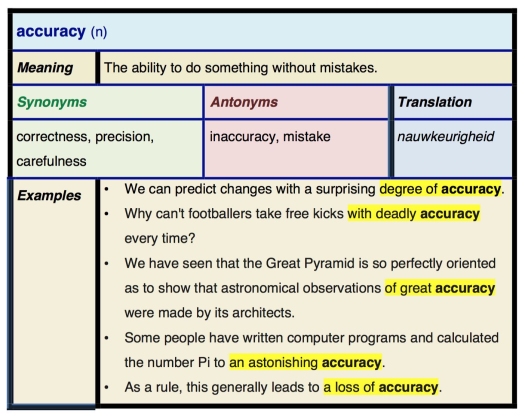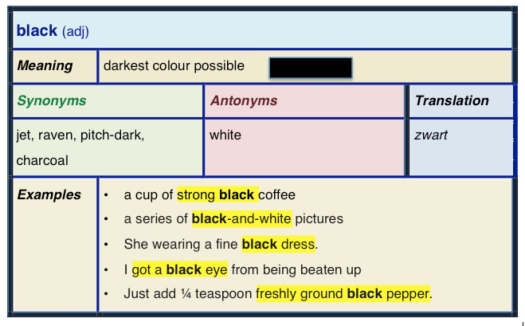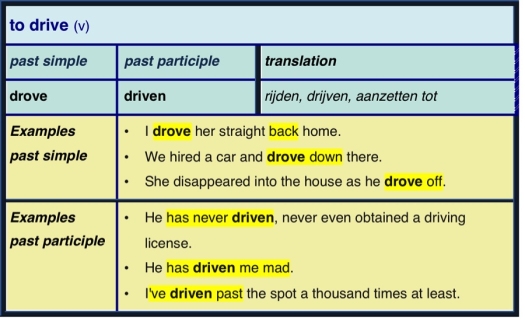More than words… On the Importance and Shape of Vocabulary Lists
Bruno Leys, Belgium
Bruno Leys works as a teacher trainer at VIVES University College, Bruges, Belgium. He has published over 20 EFL coursebooks in Belgium.
E-mail: bruno.leys@vives.be

Menu
Introduction
Background
Alternatives
Conclusions
References
In the past, when I was on tour to promote some coursebooks I had fathered, I was relentlessly confronted with the question “What about vocabulary lists? Aren’t there any vocabulary lists in the book?” Indeed, there were no prefabricated word lists to study included. Moreover, I have strong doubts about the purposefulness of such lists as I will illustrate in this article. I believe learners should work with real samples of language. Corpora, for instance, can be quite helpful resources to find relevant examples of usage as they provide us with information on frequent collocations.
Criado (2009) stated that the teaching and learning of vocabulary lists have been at the core of the teaching / learning process in the classroom for centuries.
I will first try to analyse why teachers (and according to them “learners”) are so fond of vocabulary lists. Based on what teachers and learners have told me, I can only conclude that vocabulary lists are so much in demand mainly because of their learnability. Learners know what they have to study for the test and what to expect; viz. gap fill, translations or similar, mainly non-contextual, test types. These lists are easy, for most learners, to memorise, and very practical for teachers to test and correct, so everyone is happy as can be.
Meara (1995) claimed that presenting vocabulary in list form is an efficient study method in which students can learn large numbers of words in a short time. In his view it might be sensible to teach beginners a very large vocabulary very quickly as the actual figures for English suggest that a basic vocabulary of about 2,000 words accounts for about 80% of what we see or hear. His suggestions reminisce of the grammar-translation method and current practice in the teaching of Latin and Greek. By studying this word list you will get access to texts in the foreign language. It may also be true that if learners regularly meet these words they will be able to remember them. On the other hand the list will lack context, will lead to incomplete knowledge of words and therefore the list itself will not prove very useful in the actual recalling of words in interaction.
Schmitt and Schmitt (1995) have suggested that learners should write the new words on index cards, so that they are more engaged in their learning process and use the list more effectively for their own purposes. They can cast away the words they remember and focus on the ones yet to master. However, it seems more than likely that, in both cases, learners will forget these words, stripped of all context-based meaning, after a short time.
The main difficulty with word lists remains: the absence of context. In an attempt to remedy this, present day vocabulary lists are often tied to a reading passage to provide context. The result is a format which is still easy to memorize, and is then believed to give exposure to meaning in context, resulting in longer retention of the thus learned words. Still learners are always confronted with that same sentence (or longer stretch of text). By no means, is real transfer to new contexts, guaranteed by those “contextual” vocabulary lists. The primes for the words in the list are translations or at best a single sentence.
Some coursebooks gather words in lexical sets (e.g. feelings, body parts, household chores …) , yet Hoey (2005) has shown that thematically gathered words often confuse more than they actually stick.
I believe that there is a lot of truth in the words of Earl Stevick, an American linguist, who memorably said: "If you want to forget something, put it in a list" (cited in Lewis, 1993, p. 118). In the context of this article, we could transform that quote to “If you want to forget a word, put it in a list”. In what follows I hope to clarify that this quote is more than just a witticism.
In order to find alternative and more successful ways to expand the learner’s vocabulary we should look at what else we know about learning and more specifically, vocabulary learning.
Alroe and Reinders (2105), when looking at the role of translation in vocabulary acquisition, concluded their research by stating that if we want students to be able to use words in context, we need to have them study vocabulary in context or in context with translation as well.
The most influential publications on lexis in the past 25 years have, without doubt, been Michael Lewis’s The Lexical Approach (1993) and Michael Hoey’s Lexical Priming (2005). Hoey built on Lewis’s assertions and tried to find evidence for them.
Priming, which as such is not a linguistic but a psychological concept, is a factor that influences the accessibility of information in memory. Hoey’s Lexical Priming theory shows that our prior experience of words, makes us expect words to be in the company of other words (collocations), in certain grammatical situations (grammatical colligations) and in certain positions (textual colligations).
Hoey (2005) explicitly mentioned his fear that the practice of learning words in lists (with translation) will aggravate the influence of priming differences for words in L1 and L2. Vocabulary lists with translation only, both strip the words of all their primings and assert strict parallelism between L1 and L2.
If we try to transfer the above to vocabulary learning, we need to answer the questions: what can help us retrieve learned words from our memory and primarily, what can help us effectively store new words in our memory?
More is more. The more learners are confronted with a word in changing contexts, the more lexical primes learners will store in their minds. Teachers should make words reappear frequently in texts (reading, listening, video) so that collocations and colligations are collected in the learners’ minds. Corpora can be used to find frequent collocations and realistic examples of usage.
If we take the learners’ and teachers’ demand for vocabulary lists seriously, which I think we should, the above also has its consequences for those lists. What follows are some guiding principles for more useful vocabulary lists.
- Do not list isolated words (no meaning is linked).
- Do not list words with a translation only (no context).
- Do not list words with a single context (no transfer, limited collocation and colligation)
- Do add several contexts, which stimulate transfer and show collocation and colligation.
- Highlight common and useful collocations and colligations in the sentences in the list.
- Add a translation and/or definition of the word, so that any possible ambiguity is eliminated.
- Add antonyms and closely related synonyms. They work as lexical primes.
- Add visuals that will help remember the concepts.
- Provide ample opportunity for wide contextual learner practice that primes retrieval of words from the list. The vocabulary list will never do the job!
A vocabulary list entry for the word ‘accuracy’, following the principles above could then look like this:
Figure 1: vocabulary list entry for ‘accuracy’

Naturally not all words may need such elaborate entries. This will depend on their complexity and the amount of typical collocations. A more straightforward word like ‘black’ could have the following entry.
Figure 2: vocabulary list entry for ‘black’

Ideally it would also be accompanied by pictures, which will help store the word.
Figure 3: pictures with the vocabulary list entry for ‘black’

These vocabulary list entries are naturally only part of the story. They are only a means to gather the vocabulary that learners are expected to master. The vocabulary list can only accommodate to link the words to all possible primes that could help retrieval when really needed.
As mentioned above it is especially the learners’ frequent encounters (in and outside the classroom) with words that will effectively store them in their memories. Or as Schmitt (2008) stated: “It is a commonsense notion that the more a learner engages with a new word, the more likely they are to learn it.” According to Schmitt there is a range of other factors that recur throughout the literature as facilitating vocabulary learning, including the following:
- increased frequency of exposure;
- increased attention focused on the lexical item;
- increased noticing of the lexical item;
- increased intention to learn the lexical item;
- a requirement to learn the lexical item (by teacher, test, syllabus);
- a need to learn/use the lexical item (for task or for a personal goal);
- increased manipulation of the lexical item and its properties;
- increased amount of time spent engaging with the lexical item;
- amount of interaction spent on the lexical item.
I believe that we should also apply the principles that I have linked to vocabulary lists to another very popular type of list; viz. irregular verbs. It will prove quite impossible to find a coursebook without such list included. Students around the world spend time drilling such series until they know them by heart.
The issue is, though, that the primes for the irregular forms are either the verb’s infinitive or the translation and not the words these forms naturally co-occur with. No context is provided at all.
In his webinar “Down with grammar”, Dennis Newson (2012) said that these lists are probably derived from the human desire or need to make sense of a pretty chaotic world. He added, though that he does not believe that memorising such lists will contribute much to anybody’s command of the use of the language.
Allow me to also suggest a new format for these irregular verb lists.
Figure 4: list entry for the irregular verb ‘to drive’

Once again adding pictures may be of surplus value here, too.
Figure 5: pictures with the list entry for the irregular verb ‘to drive’

I believe that instead of stacking extensive lists of irregular verbs, a lexical treatment is to be preferred. Insist on context and usage. The aim is not the reproduction of the list but usage.
I have illustrated that traditional vocabulary lists, however popular they may still be, are far from effective tools for successful vocabulary acquisition. Other formats, as presented above, which contain more focus on several contexts, collocation and connotation are to be preferred. The point can never be “knowing a list”. The focus in vocabulary teaching should be expanding the amount of language that learners have at their disposal in order to create efficient and adequate communication. If we let our learners engage more with words, they should be able to accomplish that goal.
Alroe, M. J., Reinders, H. (2015). The role of translation in vocabulary acquisition: A replication study. Eurasian Journal of Applied Linguistics 1, 39-58.
Criado, R. (2009). The Distribution of the Lexical Component in ELT Coursebooks and its Suitability for Vocabulary Acquisition from a Cognitive Perspective. A Case Study. International Journal of English Studies. Special Issue. 39-60
Hoey, M. (2005) Lexical Priming. A new theory of words and language. Routledge.
Meara, P. (1995). The importance of an early emphasis on L2 vocabulary. The Language Teacher, 19 (2), 8-10.
Newson, D. (2012) Down with Grammar. EVO Webinar. Retrieved from https://iatefl.adobeconnect.com/_a875541554/p5y4vlgdqj9/
Schmitt, N. (2008). Instructed second language vocabulary learning. Language Teaching
Research, 12(3), 329-363
Schmitt, N. & Schmitt, D (1995). Vocabulary notebooks: theoretical underpinnings and practical suggestions. In ELT Journal 49 (2), pp 133-143

Please check the English Language Improvement for Teachers course at Pilgrims website.
Please check the English Language Improvement for Adults course at Pilgrims website.
Please check the Creative Methodology for the Classroom course at Pilgrims website.
Please check the Methodology & Language for Secondary Teachers course at Pilgrims website.
Please check the Teaching Advanced Students course at Pilgrims website.


|